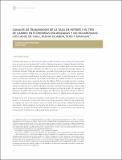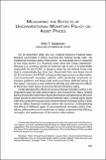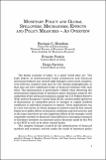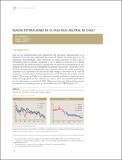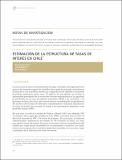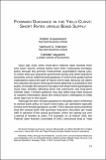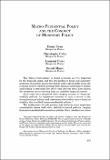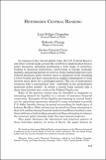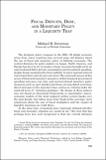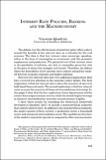Search
Now showing items 1-10 of 17
Canales de transmisión de la tasa de interés y el tipo de cambio en economías dolarizadas y no dolarizadas: los casos de Chile, Nueva Zelanda, Perú y Uruguay
Este trabajo realiza un estudio comparativo de dos de los canales de transmisión de la política monetaria —la tasa de interés y el del tipo de cambio— entre dos economías que operan bajo un sistema establecido de metas de inflación, Chile y Nueva Zelanda, y dos economías cuyo régimen de metas de ...
Measuring the effects of unconventional monetary policy on asset prices
On 16 December 2008 the U.S. Federal Reserve’s Federal Open Market Committee (FOMC) lowered the federal funds rate—its traditional monetary policy instrument—to essentially zero in response to the most severe U.S. financial crisis since the Great Depression. Because U.S. currency carries an interest ...
Monetary policy and global spillovers: mechanisms effects and policy measures: an overview
The global economy of today 'is a small world after all.' The high degree of international trade integration and financial interconnectedness has created tight linkages across most countries even between countries that may be very distant geographically or that may not have significant trade or financial ...
Nuevas estimaciones de la tasa real neutral de Chile
Una de las características más llamativas del escenario internacional es el bajísimo nivel que han alcanzado las tasas de interés de largo plazo en las economías desarrolladas. Este fenómeno se puede explicar en parte por la debilidad cíclica de dichas economías y de la agresiva respuesta de política ...
Estimación de la estructura de tasas de interés en Chile
La estructura de tasas de interés permite recoger en tiempo real expectativas de agentes del mercado respecto de variables claves para la economía: movimientos futuros de la tasa de política monetaria y expectativas de inflación al horizonte de política monetaria, entre otras. El objetivo de este ...
Forward guidance in hte yield curve: short rates versis bond supply
Since late 2008 when short-term interest rates reached their zero lower bound central banks have been conducting monetary policy through two primary instruments: quantitative easing (QE) in which they buy long-term government bonds and other long-term securities and so-called forward guidance in which ...
Macro-prudential policy and the conduct of monetary policy
The 'Great Contraction' in global economic activity triggered by the financial crisis and the extraordinary fiscal and monetary measures that public authorities had to undertake in order to put the economy back on track by putting public finances under heavy strains and leading to extremely low ...
Heterodox central banking
In response to the current global crisis the U.S. Federal Reserve and other central banks around the world have implemented diverse policy measures including purchasing a wide range of securities lending to financial institutions intervening in foreign exchange markets and paying interest on reserves. ...
Fiscal deficits debt and monetary policy in a liquidity trap
The dramatic policy response to the 2008-09 global economic crisis from many countries has revived some old debates about the use of fiscal and monetary policy in fighting recessions. The central dilemma for policy-makers in Japan North America and Europe has been to try to counter a large recession ...
Interest rate policies banking and the macroeconomy
The debate over the effectiveness of monetary policy often centers around the benefits of low interest rates as a stimulus for the real economy. The idea is that low interest rates encourage spending either in the form of consumption or investment and this promotes employment and production. The ...

